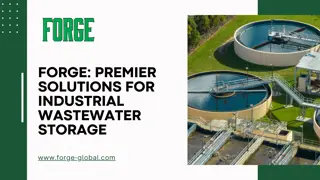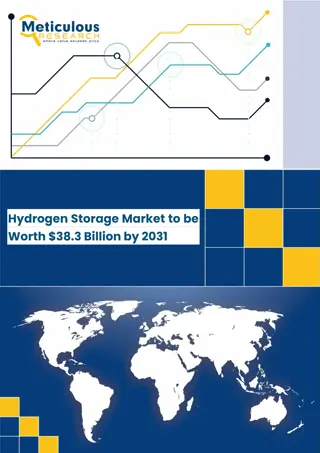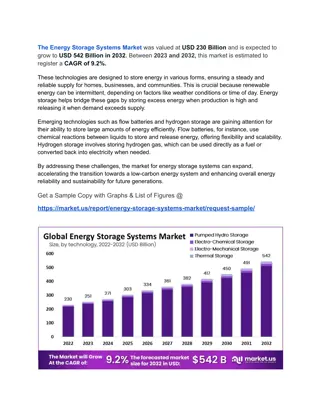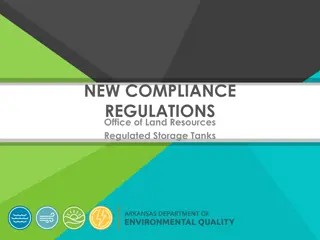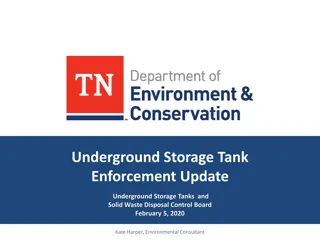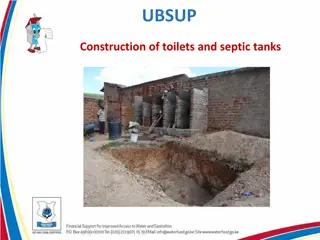Design Considerations for Storage Tanks
Storage tanks play a crucial role in various industries for holding liquids or gases, such as raw materials, intermediate products, fuels, and off-grade materials. Different types of storage tanks are available, including vertical and horizontal cylindrical tanks with various bottom shapes. The choice of tank design depends on the stored fluid's flash point. Fixed roof tanks are used for liquids with high flash points, while floating roof tanks are ideal for substances with lower flash points. Understanding the importance of storage tank design is essential for ensuring safe and efficient operations in industrial facilities.
Download Presentation

Please find below an Image/Link to download the presentation.
The content on the website is provided AS IS for your information and personal use only. It may not be sold, licensed, or shared on other websites without obtaining consent from the author. Download presentation by click this link. If you encounter any issues during the download, it is possible that the publisher has removed the file from their server.
E N D
Presentation Transcript
General Design Considerations Storage tanks General Design Considerations Storage tanks
Storage facilities are required for: Raw materials Intermediate products Final products Recycle materials Off-grade materials Fuels A storage tank is a container, usually for holding liquids, sometimes for compressed gases (gas tank). The word "tank" originally meant "artificial lake" and came from India. Storage tanks are available in many shapes: vertical and horizontal cylindrical; open top and closed top; flat bottom, cone bottom. Large tanks tend to be vertical cylindrical, or to have rounded corners (transition from vertical side wall to bottom profile, to easier withstand hydraulic hydrostatically induced pressure of contained liquid.
Choice of storage tanks Tanks for a particular fluid are chosen according to the flash-point of that substance. What is a flash point? Generally in refineries and especially for liquid fuels, there are: A) fixed roof tanks, and B) floating roof tanks.
A) Fixed roof tank Used for liquids with very high flash points, (e.g. fuel oil, water, bitumen etc.) Cone roofs, dome roofs and umbrella roofs are usual fixed roof tank
Advantages of fixed roof tank: Easy to construct and cheap to build. Disadvantages: Material losses due to the escape of vapour. BREATHING LOSSES OF A FIXED-ROOF TANK
B) Floating roof tanks The floating roof tanks are developed to store volatile liquids to minimize the loss of valuable vapors, as well as, to minimize the hazard of dangerous vapor formation underneath a fixed roof. Floating roof tanks are broadly divided into: 1) external floating roof tanks (usually called as floating roof tanks: FR Tanks) and 2) internal floating roof types (IFR Tanks). external floating roof type
FR tanks do not have a fixed roof (it is open in the top) and has a floating roof only. Applications of FR tanks: Medium flash point liquids such as naphtha, kerosene, diesel, crude oil etc. are stored in these tanks.
2) IFR tanks are used for liquids with low flash-points (eg. gasoline, ethanol). These tanks are nothing but cone roof tanks with a floating roof (steel disc) inside which travels up and down along with the liquid level. This floating roof traps the vapor from low flash-point fuels. Floating roofs are supported with legs on which they rest. IFR tanks
Advantages of floating roof tanks: Reduce material losses and air pollution. Reduce fire and explosion risk due to very small vapour space. Disadvantages: High cost. Components of IFR tank
Materials of construction for storage tanks While steel remains one of the most popular choices for tanks, there are other materials increasing in popularity such as: GRP Thermoplastic Polyethylene Fiberglass They offer lower build costs and greater chemical resistance, especially for storage of specialty chemicals.
Tank Wall Thickness The tank wall must withstand: Hydrostatic pressure of the liquid Wind loading The minimum wall thickness required to resist the hydrostatic pressure can be calculated from the equation: where Tt: tank thickness required at depth HL, mm; HL: liquid depth, m; L: liquid density, kg/m3; E: joint efficiency (if applicable); g: gravitational acceleration, 9.81 m/s2; St: maximum allowable stress for tank material, N/mm2; Dt: tank diameter, m.
Important note: Since most liquids can spill, evaporate, or seep through even the smallest opening, special consideration must be made for their safe and secure handling. This usually involves building a bunding, or containment dike, around the tank, so that any leakage may be safely contained. In some cases these area is called the tank farm. Storage Tanks Farm
Tank failures There have been numerous catastrophic failures of storage tanks. These failures may be attributed to: 1. Poor design and construction, with a wall too thin to bear repeated loads from the contents. 2. The tank had not been tested before use by filling with water, and was also poorly riveted. 3. Corrosion problem, so storage tanks must be protected against corrosion (e.g cathodic protection) 4. Faulty welding or by sub-standard steel.
However, storage tanks also present another problem, surprisingly, when empty. If they have been used to hold oil or oil products such as gasoline, the atmosphere in the tanks may be highly explosive as the space fills with hydrocarbons. If new welding operations are started, then sparks can easily ignite the contents, with disastrous results for the welders. Using an inert gas blanket to prevent explosive atmospheres building up from residues may solve this problem.






